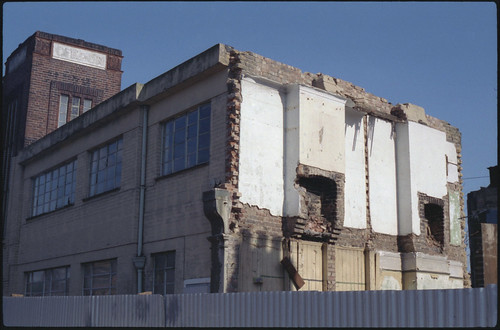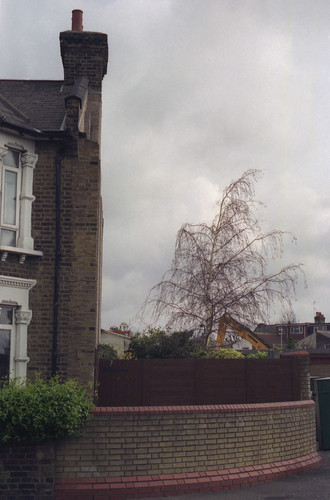 |
| Yashica 8T-2 double-8 camera |
Following my experiences with the Bolex B-8VS, I wanted a compact 2x8mm camera to replace it, and for similar reasons–something small enough that could go in my camera bag alongside still film cameras. There are numerous all-mechanical and all-manual 8mm cameras from the same era as the Bolex which have a similar design; slightly earlier 8mm cameras were often less streamlined-looking, such as the Bell & Howell turret cameras, or simply bigger and more boxy, like the early Kodaks with their huge internal sprocket wheel; the design of the compact Bolex 8mm camera must have inspired the first generation of post-war 8mm cameras, as many compact double-turret cameras appeared looking rather similar around the same time.
One camera that came up in my research was the Yashica 8T-2; there were four different initial Yashica 8mm models before the Yashica T3. This features a three-lens turret and makes for a larger camera with a redesigned body. The features of the two-lens turret models are very similar to the Bolex in compact size, shape and layout. I may have been alerted to the Yashica 8T-2 by the video on the Film Photography Project's YouTube channel; similar to the Bolex B8VS, I bought the camer before a trip abroad, to Belgium this time. There are a few evolutionary differences from the earlier Yashica 8mm cameras: the original Yashica 8 from 1957 has a different shutter release and single frame setting (more like the contemporary Bolex) and a different door catch; there then was a single lens Yashica 8S from 1958, and the 8T and 8T-2 from the same year; Yashica triple-lens turret cameras began the following year. There seems to be little difference between the 8T and 8T-2: the cameras have simply "yashica-8" embossed on the door (from reading the Yashica TLR website, the distinction between the two is unclear: the impression I get is that the Yashica 8T was actually the same camera as the 8T-2 but offered with one lens only at the time of purchase).
The first Yashica 8mm model came with Zunow lenses; my camera arrived with a Yashinon f1.4 13mm lens, with the Yashinons featuring an almost identical desgin to the equivalent Zunow lenses from which they must have derived. For the pictures on this post I fitted a Cinetor one-and-a-half inch lens from a different camera, which incidentally has a stuck focus ring–when using the camera I used the 38mm Bolex Kern Paillard lens for a long lens option (which is quite compact compared to the Cinetor, nearly as short as the Yashinon 13mm lens). As the lens mounts on the turret are a standard D-mount, there are many interchangeable lenses that can be fitted to the camera. The Yashinon f1.4 13mm lens does not focus quite as close as the equivalent on the Bolex, but it does focus to 1 foot; focus is manual and not reflected in the viewfinder of course. The 13mm lens stops down to f22, useful for bright subjects when shooting faster contemporary emulsions.
One difference from the Bolex B8 is the mechanism for framing viewfinder to different focal lengths. On the Yashica there is a slider on the side with adjusts the viewfinder from 6.5mm, through 13mm and 25mm to 38mm lenses–unlike the Bolex, the wide angle lens doesn't require an adpator for the wide angle lens. It also has a set of markings with very small numerals inside at the bottom of the scale alongside the word "SCOPE". This was for a set of animorphic lenses, which, when combined with an animorphic adaptor on the viewfinder gave a widescreen projection–various widescreen aspect ratios becoming popular in the cinema, in part as a means to compete with the developing television market. The animorphic 'scope' lenses did require an adaptor which slipped over the front of viewfinder to mask it for the correct aspect ratio; these lenses appear to be very rare now. There was also an early zoom lens produced for the camera which had a mechnical arm which connected the lens barrel to the viewfinder slider, thus providing the correct angle of view when adjusting the focal length.
Loading the Yashica 8T-2 is a little simpler than the Bolex: the camera opens with a latch that lifts up and turns. Inside, the pressure plate does not have to be opened as a separate operation: it is sprung to open automatically when the camera itself is opened: an angled linear spring inside the door pushes the pressure plate into place when the camera is closed again. Unlike the Bolex, the lower spindle inside the camera does have the four teeth at its base to ensure that the 8mm spool is correctly oriented; the original Yashica spool which came with the camera is both numbered for sides 1 and 2 and has a different colour for each side too. The film path is marked with white lines with arrows for the correct threading and loop forming of the film. At the bottom right of the camera interior is a sprung pin which resets the footage counter when released: this is in a small round window on the back of the Yahsica 8T-2 in a very similar position to that of the Bolex B8. There is also a tripod socket on the base, offset presumably to balance the weight and motion of the srping motor; it also doubles as an attachment point for a hand strap, which my camera came with. Timed without film, at 16fps, the camera's motor runs for a full 30 seconds on one complete wind.
Without the Bolex's variable shutter, the controls on the side of the camera feel a little less cluttered. There is the shutter speed dial above the winding key, and the shutter release, changed from earlier iterations of the Yashica 8 appears very much like what one might see on a typical stills camera of the period. It has a recessed port for a cable release; on the front of the camera is a sliding switch with R for run and L for lock; while running, this switch can slide into the lock position to keep the camera running without the need for any pressure on the shutter release. There is also a second cable release port in a very similar position to that of the Bolex, with the same function: this provides the single frame setting for stop motion and animation purposes.
The shutter speed dial has seven marked positions for 8, 12, 16, 24, 36, 48, and 64fps, with 16 picked out in red for normal operation. There is however an eighth position between 12fps and 16fps. This has a definite click-stop on the dial as is common with all of the speed settings. Online, and on the Yashica TLR website–from which much of the historical information fof which this post is derived–there are models where this is marked TV: this appears to be a setting for filming from a television screen and evidently a shutter speed designed to be compatible with the scanning of the cathode ray television screen, a function useful decades before the home video recorder. As to why the marking was removed but setting kept on the Yashica 8T-2–or at least my model, as it appears that some 8T-2 cameras were produced with the setting marked–can only be speculated on.
After my experiences with the Bolex B-8VS–although the Yashica 8T-2 doesn't have a variable shutter which caused the problems with that camera–I did a test of a short length of very old Fortepan film in the camera before using it for anything important. The test looked fine; to date, I've only shot one full roll of Orwo UN54 with the Yashica 8T-2 around Belgium a couple of years ago. I had wanted to make something in Bruges in response to some ideas around the book Bruges-la-Morte by Georges Rodenbach; Bruges la Morte, famously the first novel to be illustrated by photographs, inspired the crime fiction D'entre les morts by Boileau-Narcejac on which Alfred Hitchcock's Vertigo was based. The unhealthy Symbolist atmosphere of Bruges in the novel was very difficult to square with the reality of Bruges thronged with tourists on a hot early summer's day. I shot some film of the canals mostly, thinking that it could be put together some how, but as a work, I still haven't resolved it; one short shot of swan down floating on black water gives some sense of what I wanted to achieve, although the resolution isn't quite up to it perhaps.

I subsequently discovered an issue with my camera which I hadn't anticipated: dutifully locking the shutter release when putting the camera away in my bag, I discovered on taking it out again that the motor had run down and it appeared–and was obvious when I got the film developed–that the motor had been running inside the bag. On examination, with the run switch in the lock position there is a bit of resistance when the shutter release is depressed, but if one pushes hard enough the shutter release depresses fully, but–as the switch is in the lock position–the motor then runs continuously. I reasoned that had I not locked the shutter, I may possibly have wasted less film with the release springing back instead of running until the motor stopped. I also botched flipping the film to shoot side 2, as I thought I was sufficiently confident to do this in a dark bag, with the intention of getting as much usable film as possible from not exposing the end of the film to light when turning it over. I didn't load it correctly however, and I thought I was shooting a lot of footage on the second side of the reel around Antwerp before I realised the film itself wasn't going through the gate and onto the take up reel; like the Bolex, the footage counter on the Yashica 8T-2 measures the turning of the take-up reel rather than the amount of film on it, as is the case with some cameras, so this counter can be going up even if the film itself is not actually moving through the camera. The short loop below represents almost everything I actually shot in Antwerp.

Overall, the Yashica 8T-2 gives the impression of a well-designed and constructed 8mm camera, comparable to the Bolex B8, but perhaps a little more elegant, a little more curved than the solid B8, with the Yashica's design details adding to its aesthertics, such as the vertical ribs on the sides of the body, the diagonal slash of the exposure table, and its muted metallic grey, offest by the dark grey accents around the viewfinder, motor wind and exposure table–this coming from a time when cameras all suddenly began to become grey as deviation from the standard black. It also belongs to the period in the 1950s before plastic started to be comonly used in camera construction and as such–issues with the lock lever on my camera notwithstanding (I have thought it should be possible to fashion a small guard or sleeve to fit around the shutter release when not in use instead of relying on the lock switch)–it gives a confidence in the hand, and in use, at nearly seventy years old the Yashica 8T-2 is one of the better compact, all-manual 8mm cameras around.
Sources/references
The Yashica 8 ciné cameras on Yashica TLR
Yashica 8T2 manual
Yashica 8T2 on Anna & Terry Vacani Binocular and Cine Collection
Yashica 8T2 Overview on Film Photography Project


















































